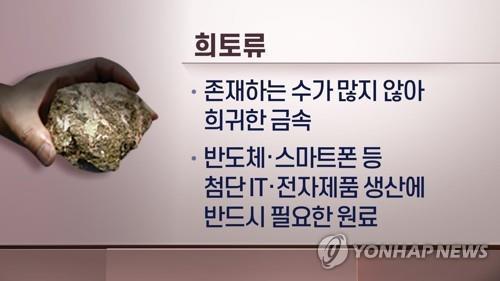(Tokyo = Yonhap News) Correspondent Park Se-jin = Four countries (quads), including the United States, Japan, India, and Australia, who are in agreement with China’s checks for the position of the world’s most powerful nation, are working together to strengthen the supply and supply chain of rare earths.
According to the Nippon Geizai Shimbun (Nikkei) on the 12th, these four countries are working on a plan to secure rare earths stably in order not to be swayed by China.
Rare earth is a key material called’industrial vitamins’ because it is a generic term for 17 elements and improves material performance by simply adding a small amount.
Among these, neodymium, dysprosium, and terbium are raw materials for high-performance magnets, and are also used in hard disk drives (HDD), electric vehicles (EV), and wind turbine motors. There are also elements essential for the manufacture of weapons.
Originally, the United States, Australia, and Russia were the main producers, but China, which is relatively loosely regulated due to the problem of radioactive substances contained in ore, has become a major producer, accounting for about 60% of the world market share.
As China almost monopolizes the process of separating and refining rare earths that cause environmental problems such as soil pollution, it is known that the US also imports 80% of domestic ore after refining it from China.
![Rare Earth Explained (CG) [연합뉴스TV 제공]](https://i0.wp.com/img0.yna.co.kr/etc/inner/KR/2021/03/12/AKR20210312052900073_01_i_P4.jpg?w=560&ssl=1)
Rare Earth Explained (CG) [연합뉴스TV 제공]
Japan was in 2010 Senkaku (Chinese name Diao Yudao)<釣魚島>) As China virtually stopped exports over the archipelago dispute, the import price of some rare earths soared nine times, causing a big blow to related companies.
Japan has since sought alternatives, such as lowering its dependence on China from 90% to 60% in 2009 by expanding its procurement sources to Vietnam and other places, and developing motor technology that does not use rare earth, but still has not escaped from dependence on China.
In this situation, U.S. President Joe Biden signed an executive order on the 24th of last month to cooperate with allies within 100 days to develop a strategy to strengthen the global supply chain of four key items, including semiconductors, large-capacity batteries for electric vehicles, pharmaceuticals, and important minerals. .
![US President Joe Biden signs an executive order on the maintenance of the global supply chain for four key items, including semiconductors, large-capacity batteries, pharmaceuticals, and important minerals on the 24th of last month. [로이터=연합뉴스 자료사진]](https://i0.wp.com/img1.yna.co.kr/etc/inner/KR/2021/03/12/AKR20210312052900073_02_i_P4.jpg?w=560&ssl=1)
US President Joe Biden signs an executive order on the maintenance of the global supply chain for four key items, including semiconductors, large-capacity batteries, pharmaceuticals, and important minerals on the 24th of last month. [로이터=연합뉴스 자료사진]
Nikkei said that the first step under this order was cooperation between members of the’quad’ on rare earth minerals, which are mineral minerals, and the leaders of the four countries confirmed the need to decentralize the rare earth supply chain, which is highly dependent on China, at the first meeting held online this night (Korean time). Expected.
Concrete measures based on this are expected to be discussed at the working level.
Nikkei predicted that the leaders of the four countries share security concerns arising from China’s expansion of maritime hegemony and put rare earths in the forefront of cooperation to contain China.
As a specific cooperative plan, it is known that joint development of technology that minimizes radioactive waste while minimizing radioactive waste in the process of refining rare earth, and providing financial support to the mining and refining sectors is known.
In this regard, Nikkei analyzed that it means that the US government supports the refining of Australian ore in the US and is considering participating in Japan as well, which means that it will boost the rare earth industry of countries other than China in terms of funding.
![Quad Video Summit (PG). [홍소영 제작] illustration](https://i0.wp.com/img2.yna.co.kr/etc/inner/KR/2021/03/12/AKR20210312052900073_03_i_P4.jpg?w=560&ssl=1)
Quad Video Summit (PG). [홍소영 제작] illustration
In addition, the quad members are planning to pursue the establishment of rules at the International Energy Agency (IEA) level that can put a brake on China’s export restrictions on rare earths, and consider making regulations requiring each country to report its stockpile.
According to data from the US Geological Survey (USGS) cited by Nikkei, China once accounted for about 90% of the world’s rare earth production.
However, as the U.S. and Australia, feeling a sense of crisis, increased production, China’s share fell to 58% as of last year.
As of last year, the share of rare earth production was 16% in the US and 7% in Australia.
India, which is a quad member, accounts for 6% of its reserves, and Japan is the world’s third-largest country consuming rare earths in terms of imports.
Unauthorized reproduction-redistribution prohibited>
2021/03/12 10:08 sent
